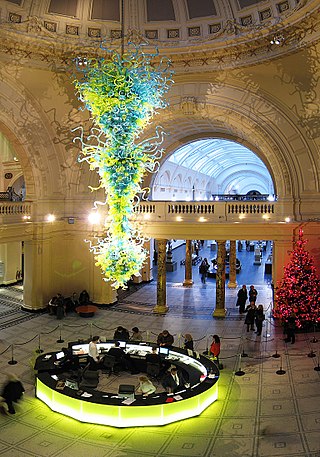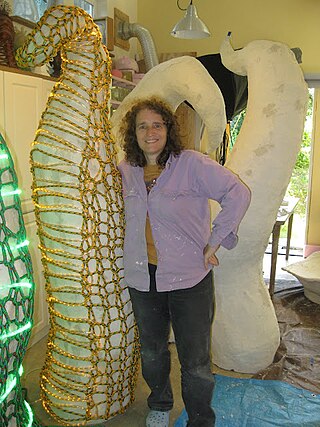
The Smithsonian American Art Museum is a museum in Washington, D.C., part of the Smithsonian Institution. Together with its branch museum, the Renwick Gallery, SAAM holds one of the world's largest and most inclusive collections of art, from the colonial period to the present, made in the United States. The museum has more than 7,000 artists represented in the collection. Most exhibitions take place in the museum's main building, the old Patent Office Building, while craft-focused exhibitions are shown in the Renwick Gallery.

The Renwick Gallery is a branch of the Smithsonian American Art Museum located in Washington, D.C. that displays American craft and decorative arts from the 19th to 21st century. The gallery is housed in a National Historic Landmark building that was opened in 1859 on Pennsylvania Avenue and originally housed the Corcoran Gallery of Art. When it was built in 1859, it was known as "the American Louvre".

American craft is craft work produced by independent studio artists working with traditional craft materials and processes. Examples include wood, glass, clay (ceramics), textiles, and metal (metalworking). Studio craft works tend to either serve or allude to a functional or utilitarian purpose, although they are just as often handled and exhibited in ways similar to visual art objects.
Marvin Bentley Lipofsky was an American glass artist. He was one of the six students that Studio Glass founder Harvey Littleton instructed in a program at the University of Wisconsin-Madison in fall 1962 and spring 1963. He was a central figure in the dissemination of the American Studio Glass Movement, introducing it to California through his tenure as an instructor at the University of California, Berkeley and the California College of Arts and Crafts.
Judith Schaechter is a Philadelphia-based artist known for her work in the medium of stained glass. Her pieces often use symbolism from stained glass and Gothic traditions, but the distorted faces and figures in her work recall a 20th century German Expressionist painting style and her subject matter is secular. Shaechter's work often involves images that might be considered disturbing such as death, disease, or violence. Early Schaechter pieces, for example, such as King of Maggots and Vide Futentes make use of memento mori, symbols of death found in church architecture during medieval times.

Albert Paley is an American modernist metal sculptor. Initially starting out as a jeweler, Paley has become one of the most distinguished and influential metalsmiths in the world. Within each of his works, three foundational elements stay true: the natural environment, the built environment, and the human presence. Paley is the first metal sculptor to have received the Lifetime Achievement Award from the American Institute of Architects. He lives and works in Rochester, New York with his wife, Frances.
Preston Singletary is a Native American glass artist.

Dan Owen Dailey is an American artist and educator, known for his sculpture. With the support of a team of artists and crafts people, he creates sculptures and functional objects in glass and metal. He has taught at many glass programs and is professor emeritus at the Massachusetts College of Art, where he founded the glass program.

Richard Ritter is an American studio glass artist who lives in North Carolina.
Therman Statom is an American Studio Glass artist whose primary medium is sheet glass. He cuts, paints, and assembles the glass - adding found glass objects along the way – to create three-dimensional sculptures. Many of these works are large in scale. Statom is known for his site-specific installations in which his glass structures dwarf the visitor. Sound and projected digital imagery are also features of the environmental works.
Fritz Dreisbach is an American studio glass artist and teacher who is recognized as one of the pioneers of the American Studio Glass Movement.
Sonja Blomdahl is an American blown glass artist.

Carol Milne is an internationally recognized Canadian American sculptor living in Seattle, Washington. She is best known for her Knitted Glass work, winning the Silver Award, in the International Exhibition of Glass Kanazawa Japan 2010.
Paul J. Smith was an arts administrator, curator, and artist based in New York. Smith was professionally involved with the art, craft, and design fields since the early 1950s and was closely associated with the twentieth-century studio craft movement in the United States. He joined the staff of the American Craftsmen's Council in 1957, and in 1963 was appointed Director of the Museum of Contemporary Crafts, a position he held for the next 24 years. In September 1987, he assumed the title of director emeritus and continued to work as an independent curator and consultant for museums, arts organizations, and collectors.
Debora Moore is a contemporary glass artist. She is best known for her glass orchids.
Jack Earl is an American ceramic artist and former teacher, known for drawing inspiration from his home state of Ohio to create rural pieces “with meticulous craftsmanship and astute details… to where you could smell the air, hear the silence and swat the flies.” Although his works hint at highly personal, intellectual, and narrative themes in an almost unsettling manner, Earl is “a self-described anti-intellectual who shuns the art world." He is known particularly for using his trademark format, the dos-a-dos : “This art form is like a book with two stories… the two seemingly incongruent images prompt the viewer to fill in the conceptual gap through poetic speculation.” His work often involves dogs or the character “Bill”, who is said to be a combination of Earl’s father-in-law, himself, and others. The titles to his pieces are typically lengthy, stream-of-consciousness narratives that suggest the folk or rural lifestyle. These are intended to add another dimension to the artwork. His work has received a notable response over his decades-long career, especially since he is regarded as “a master at reminding us that within the events we take for granted are moments of never-ending mystery and wonder.” Earl continues to live in Lakeview, Ohio with his wife, Fairlie.
Susan Stinsmuehlen-Amend is a glass and mixed media artist who lives and works in Ojai, California.

Michael Janis is an American artist currently residing in Washington, DC where he is one of the directors of the Washington Glass School. He is known for his work on glass using the exceptionally difficult sgraffito technique on glass.
Objects: USA (1969) was a groundbreaking exhibition considered a watershed in the history of the American studio craft movement. It "blurred lines between art and craft, artist and artisan". The exhibition featured a survey collection of craft works by artists from across the United States. Artists were approached and works chosen by New York gallery owner Lee Nordness and curator Paul J. Smith, the director of the Museum of Contemporary Crafts. The exhibition was funded by S. C. Johnson & Son, which purchased the pieces for the exhibition and later donated many of them to American museums. The Objects: USA exhibition appeared at thirty-three locations in the United States and Europe. The accompanying exhibition catalog Objects: USA (1970) became a classic reference work.
Flora C. Mace is an American glass artist, sculptor, and educator. She was the first woman to teach at Pilchuck Glass School. Since the 1970s, her artistic partner has been Joey Kirkpatrick and their work is co-signed. Mace has won numerous awards including honorary fellow by the American Craft Council (2005).







